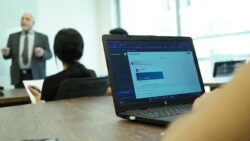Authored by
Elisa Queenan, Professor of Business and Economics, Porterville College
 The alarm on my phone goes off, it’s 10pm on a Sunday night. I yawn, physically tired but excited for tonight. Most people at this time are settling in for the evening, relaxing, and maybe planning for work the next day. I, however, am surrounded by 14 different Zoom boxes. “No slang tonight!” I tell my students before all of the others join. “We barely know what you mean when you say that’s ‘lowkey true,’ much less our peers from Kurdistan!” says Beth, our professor of Engineering. Thirteen more Zoom boxes join. I am surrounded by students from Central California and the Kurdish region of Iraq. Surrounded by teachers of engineering, education, and even a dean. We are an unlikely and perfect team.
The alarm on my phone goes off, it’s 10pm on a Sunday night. I yawn, physically tired but excited for tonight. Most people at this time are settling in for the evening, relaxing, and maybe planning for work the next day. I, however, am surrounded by 14 different Zoom boxes. “No slang tonight!” I tell my students before all of the others join. “We barely know what you mean when you say that’s ‘lowkey true,’ much less our peers from Kurdistan!” says Beth, our professor of Engineering. Thirteen more Zoom boxes join. I am surrounded by students from Central California and the Kurdish region of Iraq. Surrounded by teachers of engineering, education, and even a dean. We are an unlikely and perfect team.
I smile to myself as I listen to conversations taking place in English, Spanish, Kurdish, and Arabic. Tonight, we are investigating sustainable and stable energy sources within the northern region of Iraq. Our students came prepared with potential prototypes to create a power source in areas that frequently experience unstable supply. As a professor of business and economics, surrounded by business, engineering, history, education, and kinesiology students, you might think this is a strange thing for us to be doing, and you would be right if you only viewed education through a mainstream lens, but this is different. This is chaotic, wonderful, collaborative discovery. This is a virtual exchange.
Virtual Exchange in My Classroom
When I was first approached with the idea of doing a virtual exchange, I imagined an awful, boring seminar where people from around the world happened to occupy the same virtual space and passively listen to a speaker. I imagined walking away and being unable to articulate the value of what I just did or maybe even anything that occurred. I couldn’t have been more wrong.
While virtual exchange can vary by program, my experience involved two different countries coming together for a period of eight weeks to problem solve some issues through mutual collaboration. In this scenario, students from the Kurdish region of Iraq and students at Porterville College in California partnered through an exchange implemented by IREX. At the surprising request of my president, I agreed to co-teach this class with our engineering faculty, which contributed expertise that made the experience more enriching.
We investigated a UN Sustainable Development Goal and worked through the Human-Centered Design Process, which is like the scientific method for social science, to come up with a solution. Because students select the problem and develop a solution and prototype, the process allows educators to participate in an adventure of discovery alongside their students.
Over the last few years, our students have collaborated on a number of projects with their Kurdish peers. They’ve created a design for a micro-hydroelectric turbine to provide electricity to rural towns, they’ve created a repository of curricula to assist teachers around the world with teaching critical thinking, and they’ve designed websites that curate remote jobs so educated individuals in areas of high unemployment can remain in their community and work. While the skills of learning to assess problems and risk and create solutions and prototypes are exceptionally valuable for our students as they prepare to enter the labor market, I actually think there are more significant areas of impact.
Impact
The value of these experiences cannot be overstated for either the student or the educator. As an instructor, I’ve realized through this experience that the only barriers in my classroom instruction have been of my own creation. The lack of control, spirit of collaboration, and depth of experience in a virtual environment has led to a far more holistic view of teaching for me. I now actively seek experts in other departments for collaboration in my classroom and offer most of my courses in a HyFlex format. This offers the students a choice each week to participate face-to-face, online synchronous, or online asynchronous. While it can be uncomfortable for teachers (like myself) who love to teach face-to-face with a full class, I have come to the conclusion that teaching isn’t about me. My hope is that students can decide for themselves how they need to engage, which should increase their ability to participate. Reflections from incorporating virtual exchange into my classroom allowed a monumental shift in my pedagogical practices.
While physical exchanges are valuable for a plethora of known reasons, a virtual exchange gives a greater depth of experience for the students and educators involved. Virtual exchange allows students of both countries to be equally exposed. The burden is now on both groups to extend themselves culturally and work to understand the other group. The core of this success centers on expanding the students’ understanding and practice of empathy. For the exchange to be successful, students must be willing to set aside some of their own cultural norms and expectations to genuinely hear and see their international classmates. This allows them to not only hear what someone else is saying, but why they are saying it.
For the student, the highest areas of impact are in the cultivation of social capital through the skills of empathy, critical thinking, and collaboration. We know that social capital centers on the quantity and quality of relationships acquired and the advantage they give us in the society where we function. So often, in communities like that of Porterville College, social capital is hard to come by. In Porterville, the poverty rate is 10.5% above the national average, according to the 2020 American Community Survey, and 59.3% of the parents of our students only have a high school diploma (38.6% of that number having earned no diploma). Social capital gives students a competitive edge in the labor market. Without that readily available, experiences like virtual exchange give students the opportunity to build their own in a different facet. My Kurdish colleague, Talib, who teaches at Erbil University in Iraq, believes, “this sort of collaboration reduces the cost of learning, increases knowledge, and expands opportunity for all people to access the learning resources easily.”
Additionally, this experience changes the worldview students hold. Every semester, students tell us they feel more empowered, finally understand what it means to think critically, and feel confident tackling wicked problems with people anywhere in the world. Additionally, we have intentionally worked to create a safe space for students to be curious about the other culture and to grow in their knowledge of how to gain intercultural awareness. With these skills, our students are more equipped to venture into the world with confidence and the ability to face complicated problems and address them with their fellow citizens around the globe. As my colleague, Talib, said, “Virtual exchange is a gift and a need for the world of academia. It is a treasure of the 21st century too.”
Elisa Queenan is a Professor of Business and Economics at Porterville College. Elisa’s research primarily focuses on the economic value of postsecondary education in the States and the Middle East. She is currently a fellow through the Stanford EPIC program, which supports community college professors in internationalizing their curriculum. Most importantly, she has a wonderful, chaotic family full of amazing teenagers.
 The alarm on my phone goes off, it’s 10pm on a Sunday night. I yawn, physically tired but excited for tonight. Most people at this time are settling in for the evening, relaxing, and maybe planning for work the next day. I, however, am surrounded by 14 different Zoom boxes. “No slang tonight!” I tell my students before all of the others join. “We barely know what you mean when you say that’s ‘lowkey true,’ much less our peers from Kurdistan!” says Beth, our professor of Engineering. Thirteen more Zoom boxes join. I am surrounded by students from Central California and the Kurdish region of Iraq. Surrounded by teachers of engineering, education, and even a dean. We are an unlikely and perfect team.
The alarm on my phone goes off, it’s 10pm on a Sunday night. I yawn, physically tired but excited for tonight. Most people at this time are settling in for the evening, relaxing, and maybe planning for work the next day. I, however, am surrounded by 14 different Zoom boxes. “No slang tonight!” I tell my students before all of the others join. “We barely know what you mean when you say that’s ‘lowkey true,’ much less our peers from Kurdistan!” says Beth, our professor of Engineering. Thirteen more Zoom boxes join. I am surrounded by students from Central California and the Kurdish region of Iraq. Surrounded by teachers of engineering, education, and even a dean. We are an unlikely and perfect team.